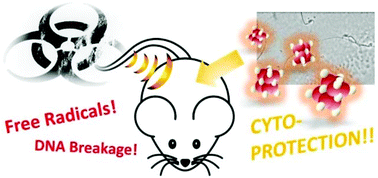Engineered nanoceria cytoprotection in vivo: mitigation of reactive oxygen species and double-stranded DNA breakage due to radiation exposure†
Abstract
Cerium oxide nanomaterials are known to absorb ionizing radiation energy, as well as to neutralize free radicals in solution, by undergoing redox changes. We, therefore, proposed that ceria nanoparticles could be used in biomedical applications as an injectable, radio-protectant material. In this study, we examine the effectiveness of engineered nanoparticles in protecting germ cells from the damaging effects of irradiation-induced cell death, in vivo. C57BL/6J male mice were used as a model and irradiation was localized to the scrotal region at 2.5, 5, and/or 10 Gy intensities. Ceria nanoparticles were introduced as 100 μL injections at 100 nM and 100 μM via tail vein injections, weekly, for one month. Following this, the animals were sacrificed and their organs (heart, brain, kidneys) were harvested. Tissues were fixed, sectioned, and stained for instances of cell death, DNA damage (TUNEL assay), and ROS (nitro-tyrosine evolution). Tissues from mice treated with ceria nanoparticles showed significantly less (∼13% decrease; *P < 0.05) tissue damage (per immunohistochemistry) over controls at up to 5 Gy radiation. DNA damage and ROS also decrease substantially with ceria treatment, confirming ceria's capacity as an injectable, radio-protectant material. The study also highlights the ability of ceria nanoparticles to protect cells/tissues from both direct and indirect effects of ionizing radiation.

- This article is part of the themed collection: 2018 Nanoscale HOT Article Collection


 Please wait while we load your content...
Please wait while we load your content...